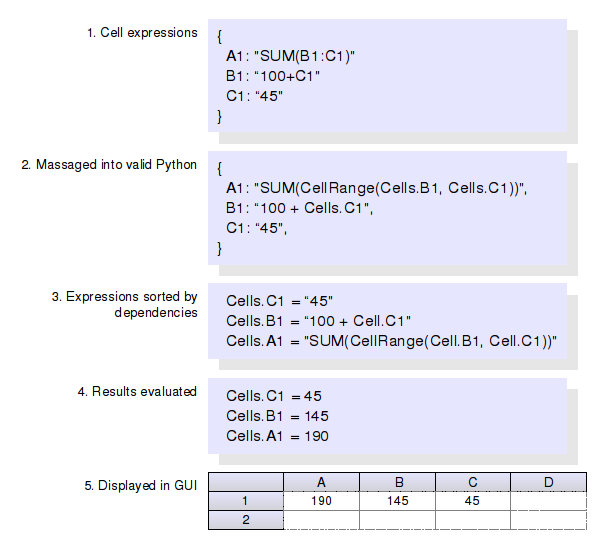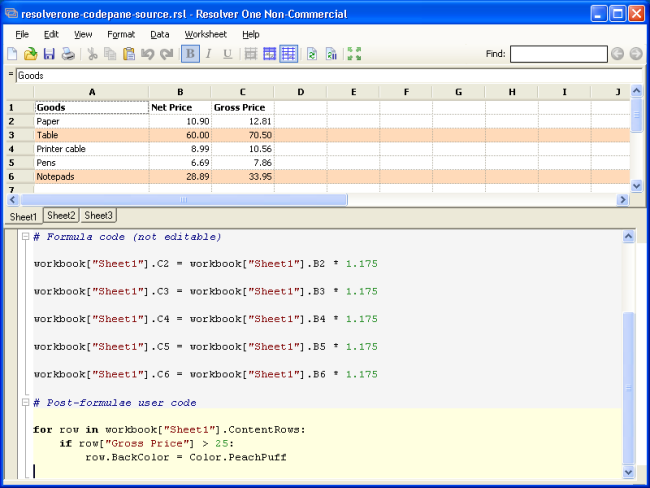Python Success Stories
Introducing IronPython
Pairing the Python language's expressivity with the seamless availability of the extensive .NET class libraries makes IronPython a powerful combination for Resolver Systems.
About Resolver Systems
Resolver Systems is a two year-old start-up based on the outskirts of London's financial district. Our first product, Resolver One, is a desktop and web-accessible spreadsheet aimed primarily at the financial services market. It is written entirely in IronPython, and directly exposes end-users to Python, both as expressions in cell formulae, and as an embedded scripting language which provides programmatic access to spreadsheet content.
Resolver One launched in Spring of 2008, by which time the team had grown to fourteen people, and the codebase to 40k lines of product and 140k lines of tests.
Why IronPython?
From the outset, it was clear that it would be good to use an existing language as our embedded scripting language, rather than inventing one. A dynamic language would confer appropriate type semantics on the spreadsheet formulae. It would be advantageous if this same language could also be used for development of the Resolver One application itself. There was also a requirement for .NET interoperability, so that both our own development team and our users could invoke existing .NET libraries, especially the powerful Graphical User Interface (GUI) components in the System.Windows.Forms module of the .NET class libraries themselves.
Python was regarded fondly by our founders, but could not directly fulfil the requirement for .NET interoperability. Python for .NET was considered, allowing Python developers to call .NET assemblies, but in the end this lost out to IronPython, a reimplementation of Python as a .NET language, which runs directly on the Common Language Runtime (CLR). At the time, IronPython felt like a somewhat risky proposition. At v0.7 it was still relatively young, and had an extremely low profile. The acquisition of IronPython by Microsoft also raised uncertainties about the project's future, should it be deemed contrary to Microsoft's strategy.
However, our initial experiments with IronPython went well. It turned out to be trivially easy to create a GUI using the excellent design tool in Visual Studio, then inherit from these classes in Python code and implement all behaviour in Python, in the Integrated Development Environment (IDE) of one's choice. (Developers choose their own IDE, so we sport an entertaining diversity of them, currently: Eclipse, Vi, Emacs, Wing, Komodo and the lightweight but surprisingly useful Textpad.)
For example, IronPython code can easily display a .NET Form, using:
# Add a reference to the required .NET assembly
# This only need be done once per application
import clr
clr.AddReference("System.Windows.Forms")
# Then import symbols from the assembly, as if from a Python module
from System.Windows.Forms import Application, Form
# Then use the imported symbols as though they were native Python types
form = Form()
form.Text = "Hello World"
Application.Run(form)
Which displays this fully-functional Windows application:

Figure 1. "Hello World" GUI application created from IronPython. Zoom in
Over time, other strengths of IronPython have become apparent. Using the .NET threading model means that applications are able to overcome CPython's global interpreter lock. Resolver One uses this to run background recalculation threads on different cores, to remain responsive during lengthy calculations.
Meanwhile, the concerns about the IronPython project have diminished. The viability and visibility of IronPython has gone from strength to strength. Today, with dynamic languages getting ever more attention, IronPython forms the flagship language for Microsoft's recent Dynamic Language Runtime (DLR), upon which future versions of Visual Basic will be based, and a healthy future seems assured.
The success of IronPython is well deserved. It has proven to be a very capable implementation, with transparent mappings between Python and .NET types, and very few differences between it and CPython to catch out unwary developers. Pairing up the expressivity and power of the Python language with the highly functional and extensive .NET class libraries is a powerful combination.
Mixing Generated and User-Written Code
Resolver One pre-processes users' cell expressions to convert common spreadsheet idioms into legal Python statements. These statements are executed to determine the values displayed in the GUI's grid. The order in which the statements are executed depends upon the dependencies between them. For example, if cell A1 references the value of B1, then B1 must be evaluated first. This provides us with the basic spreadsheet model that has proven so valuable for ad-hoc investigation of numerical models.

Figure 2. The basic steps Resolver One uses to evaluate cell formulae. Zoom in
However, using this method, it is difficult for users to create spreadsheets of any complexity without using cell expressions that are enormous and unwieldy, mixing data, business logic and presentation information. These expressions get duplicated (and almost-duplicated) many times. Any model which is more than trivial quickly degenerates into an unmaintainable 'Frankensheet'.
To combat this, Resolver One allow users to intersperse the evaluation of cell formulae with arbitrary code of their own. This is done by displaying the code that is generated from cell expressions in a pane of the GUI. The user is free to insert any Python of their own devising, to be executed before, during or after the evaluation of the spreadsheet cell values.

Figure 3. The code pane within the Resolver One application. Zoom in
So the spreadsheet, with all its data, expressions and user-customised functions and algorithms, becomes a single, executable Python script. The GUI and the code are two interchangeable views of the same underlying mathematical model - editing one automatically updates the other. This retains the accessibility and experimental immediacy of a traditional spreadsheet user interface, while allowing the user to tame the spreadsheet's complexity using the same techniques that software engineers have been inventing for the last few decades: elimination of redundancies; functional decomposition; object orientation; external libraries; and other high-level abstractions - all in a modern, fully-featured programming language.
An important feature of Python that we were rely on heavily for this, and which we were happy to see supported in IronPython, was the execution of cell formulae and user code in a separate instance of the underlying Python engine. This isolates the user's spreadsheet code from the running instance of the Resolver One application, preventing us from polluting each other's namespace, or from having to share global settings such as the Python recursion limit.
Supporting Agile Development
Python is a modern, expressive language, which supports many aspects of a modern, agile software development process.
Small Code Base
Python's high level of abstraction and expressivity allows our developers to produce complex functionality using a minimal amount of code. This has enabled a small team of engineers - linearly growing from two to fourteen employees over two years - to create a fully-featured solution with a manageable codebase.
Unit and Acceptance Testing
Python's built-in 'unittest' module provides everything needed to get started with most unit testing, and has proven extendible enough for us to gradually build our own acceptance test framework on top of it. This uses the .NET API to directly stimulate mouse and keyboard input events to manipulate the application's GUI, and then asserting the existence and content of various GUI components like windows and textboxes, to provide automated assurance of end-to-end functionality.
Test-Driven Development
Dynamic languages like Python complement automated testing, by allowing the patching of modules, classes, methods or attributes with arbitrary objects at runtime. This allows tests to easily eliminate dependencies of the code under test, and thus concentrating on testing one thing at at time. Additionally, it makes it easy to stimulate particular behaviours or failure modes during the test. For example, by patching the file 'open' function with another function which simply raises an exception, a test can easily verify how the code under test reacts if it is unexpectedly unable to open a file.
Distributed Testing Infrastructure
Resolver Systems also uses Python extensively for their internal infrastructure, from IDE scripting to a distributed test runner, which spreads the load of running many unit and acceptance tests over however many machines in the office are currently idle.
The distributed test mechanism became necessary as our test suite grew in size. We would rather over-test than under-test, and our test suites contain several hundred acceptance tests that fire up the application and pummel the GUI to put it through its paces, including performance tests on large data sets. Running all these tests takes a significant amount of time. When it grew to one hour, we developed procedures to work around it. When it grew to two or three hours, it was seriously impacting our developer's feedback cycle, so we vowed to reduce the amount of time taken to run the test suite, without compromising the coverage provided by all the diverse tests. The distributed test runner was the result.
Notably, this wasn't our first attempt at a distributed test runner. One of our genius interns had attempted a similar project the previous summer, using .NET remote procedure calls. Unfortunately, the complexity of this proved too much to nail down in the time available. In the end, in true agile style, it was a less ambitious architecture which actually got completed, by a different genius intern the following summer. This has been refined gradually ever since, and now forms an invaluable part of our daily routine.
Initiating a distributed build from a developer's PC will enumerate the tests, marking them as 'to be run' in a database, and then copy the build to shared directories on a manually listed set of 'slave' machines. Forcing developers to manually specify which machines to use was initially created as the 'simplest thing that could possibly work.' Contrary to our expectations, we have since had little motivation to automate this. It turns out that negotiation between developers over which machines to use during builds is a valuable excuse to touch base with each other about what we're up to through the day. It also provides an opportunity to fine-tune the allocation of free machines between more than one simultaneous build, when the need arises.
Once slave machines have received their copy of the build, they grab the ID of a few unallocated tests from the database, and run those tests locally, updating the database with the results. Test results are visible at any time using a web interface, which also makes it easy to ask a particular machine to drop out of the build once it has finished running it's current batch of tests. Once all test records are marked as either pass or fail, we know the build is complete.
Problems
3rd Party GUI Components with Win32 API calls means Windows Only
IronPython is a Microsoft .NET Language, and as such, is ostensibly limited to running on Windows only.
The Mono project is a fantastic effort to improve that situation, and many .NET projects will run without recompilation under Mono on Linux, Mac OS X and others. However, in our case, Resolver One uses a 3rd party grid component in our GUI, which makes direct Win32 API calls. This precludes us running on different platforms for the time being.
We are, however, working on a Mono-compatible version of Resolver Server, which is a version of Resolver One which publishes editable spreadsheets over the web, without displaying any GUI on the server.
No Python C Extension Modules
IronPython scripts can in general import and use regular Python modules. However, IronPython cannot import C extension modules. Such modules generally have a .pyd extension, and consist of compiled C or C++, exposing an API to let them be imported like a Python library.
Such modules include some of the Python standard library, such as cmath, array, parser, and subprocess. Much of this missing functionality is compensated for by the availability of equivalent .NET libraries, however this obviously damages the credibility of IronPython as a plug-in alternative implementation.
Perhaps more significantly for us, this also precludes some commonly-used 3rd-party modules such as NumPy and SciPy. Many of our clients would like to use these with Resolver One.
Resolver Systems has therefore started an open-source project, IronClad, which aims to make C extension modules callable from IronPython. There is still a lot of work to do before this project will be useful, but obviously such a technology would be of interest to all users of IronPython. Enough progress has been made thus far to demonstrate the feasibility of the approach: The bzip C extension module can currently be called from IronPython, and others will follow as we implement more of the Python C extension API.
Negative Perceptions of Open-Source
Sometimes we need to remind ourselves that people outside the software industry don't understand terms such as open source. Personally, I've had more than one informal dinner party conversation about Resolver One with finance industry people, who have stopped me to ask why on Earth we chose Python if it's an open source language? After all, isn't open source the same as freeware, ie. all rubbish?
It's hard to know how significant this perception is amongst our potential clients' decision makers, but obviously we do our best to rectify such impressions wherever we encounter them.
Performance
IronPython performance is generally comparable to CPython - faster in some regards, slower in others. It seems likely that IronPython will continue to gain on CPython as their implementation matures. This is not saying much though - benchmarks clearly show dynamic languages like Python to be significantly slower than more mainstream, statically typed languages. However, this result is not as significant as it is sometimes made out to be, for two reasons.
Firstly, many applications are rarely CPU bound, and simply do not need the intensive performance that the fastest languages can give you. For interactive desktop applications, the speed difference between C# and IronPython would rarely be discernible by the user.
Some programs do require significant CPU performance, either because they are crunching large data sets or because they must scale across many users on a server. In such a project, it is often a very small proportion of the code which actually requires this high performance. Usually it makes sense to develop the majority of the application in a language which makes it easiest for the developers to make rapid progress, then measure performance to see whether optimisation is required, and where. The offending bottleneck can often be refactored for performance, or alternatively, rewritten in another language. (C for CPython, or any .NET language for IronPython.)
Secondly, benchmarks give an overly pessimistic view of dynamic language performance. In significant real-world applications, the data sets and algorithms are significantly more complex than most benchmarks, and the higher levels of abstraction afforded by a powerful language like Python will enable developers to visualise more efficient implementations with less effort. Simply put, programs take less time to write in Python, leaving you more time afterwards to refactor for performance if necessary. Then the refactoring is easier in Python too.
For Resolver One, we do find performance problems from time to time, such as when loading very large spreadsheets. Generally we schedule a new user story to address these performance issues, much as we would for any other functionality. After a day or three of work, we have usually developed a sufficient improvement in efficiency, and will have created an acceptance test along the way to measure and monitor this going forward.
Conclusion
Using Python so extensively, for our sole product and our internal development infrastructure, has made it a mission critical component for our company's success. Python has admirably supported our requirements, from the robust features of the language itself, the excellent .NET implementation provided by the IronPython project, and the thriving community of discussion, support and tools. On the whole, our clients feel the same, as shown by this quote from "Credit Cooperatif", a large French retail bank who are now using Resolver One:
We use Excel and VBA, but we prefer Python for its combination of simplicity and power. We were looking to better link spreadsheets with Python programming, and Resolver One seemed to be the most elegant solution because it was based on Python but also gave us compatibility with our IT team’s architectural choice of Microsoft .NET.
Resolver One is Windows only, and is free for evaluation, or for non-commercial use.
About the Author
Jonathan Hartley originally came into software from a background in digital electronics. Nowadays, he is delighted to be a developer at Resolver Systems, alongside people who are all smarter than he is. He lives in London with his wife Susan and two trusty Guitar Hero controllers.
